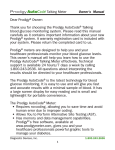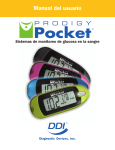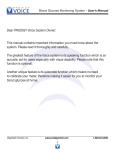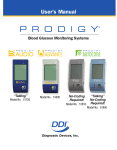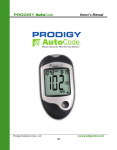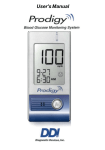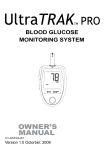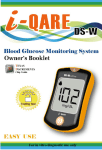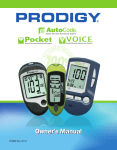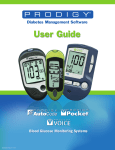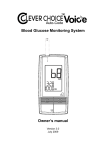Download Prodigy Pocket Owner`s manual
Transcript
Owner’s Manual Blood Glucose Monitoring System Prodigy Owner’s Manual Meter Prodigy PocketTM Meter Dear Prodigy® Owner: Thank you for choosing the Prodigy PocketTM blood glucose monitoring system. Please read this manual carefully as it contains important information about your Prodigy® system. A warranty registration card is included with your system. Please return the completed card to us. Prodigy® meters are designed to help you and your healthcare professionals monitor your blood glucose levels. This owner’s manual will help you learn how to use the Prodigy PocketTM Meter effectively. Technical support is available 24 hours/7 days a week by calling 1-800-243-2636. All questions about interpreting the results should be directed to your healthcare professionals. The Prodigy PocketTM is the latest technology for blood glucose monitoring, easy to use and will give you fast and accurate results with a minimal sample of blood. It has a large screen display for easy reading and is small and lightweight for portable convenience (fits in your pocket!). The Prodigy PocketTM Meter: • Requires no coding; allowing you to save time and avoid human error due to coding. •Allows you to perform Alternative Site Testing (AST). • Has memory and data management capabilities. Prodigy®’s free software, available at www.prodigymeter.com, gives you and your healthcare professionals powerful graphic tools to manage your diabetes. 1.800.243.2636 Diagnostic Devices, Inc. 1 Prodigy Owner’s Manual Meter Important Safety Instructions Read this before using your Prodigy PocketTM Meter. The following basic safety precautions should always be taken. •Close supervision is necessary when the device is used by, on, or near children, handicapped persons or invalids. •Use the device only for the intended use described in this manual. • Do not use test strips and control solutions that are not supplied by the manufacturer. • Do not use the device if it is not working properly, or if it has suffered any damage. • Before using any product to test your blood glucose, read all instructions thoroughly and practice the test. Do all quality control checks as directed and consult with a diabetes healthcare professional. Warning: Keep the test strip vial away from children; the vial cap and the test strips can be a potential choking hazard. Never chew or swallow a test strip. If this occurs, please seek medical assistance immediately. www.prodigymeter.com Diagnostic Devices, Inc. 2 Prodigy Owner’s Manual Meter Table of Contents Important Safety Instructions........................................................................... 2 Important Health-Related Information............................................................... 4 About Alternative Site Testing (AST)................................................................. 5 Introduction to the Prodigy Pocket Meter........................................................ 7 Intended Use.................................................................................................. 7 Test Principle.................................................................................................. 7 Contents of the Prodigy Pocket Meter............................................................. 8 Setting up the Prodigy Pocket Meter............................................................... 9 Key Functions of the Meter.............................................................................. 9 Meter Display .............................................................................................. 10 Key Functions of the Test Strip....................................................................... 11 Important Test Strip Information.................................................................... 12 Set-Up Steps................................................................................................ 13 Control Solution Testing................................................................................. 16 About Prodigy® Control Solution...................................................................... 16 Important Control Solution Test Information.................................................... 17 Performing a Control Solution Test ................................................................ 18 Blood Glucose Testing.................................................................................... 21 Preparing the Lancing Device......................................................................... 21 Getting a Blood Sample................................................................................. 22 Performing a Blood Glucose Test................................................................... 24 Using the Meter Memory................................................................................ 26 Viewing Results on a Personal Computer........................................................ 29 Caring for your Prodigy Pocket Meter............................................................. 30 Maintenance................................................................................................. 30 Battery ........................................................................................................ 30 Battery Replacement..................................................................................... 31 System Troubleshooting................................................................................. 32 Special Messages......................................................................................... 32 Error Messages............................................................................................ 33 Troubleshooting Guide................................................................................... 34 Information about your Prodigy Pocket Meter................................................ 36 Comparing Meter and Laboratory Results....................................................... 36 Specifications................................................................................................ 38 Performance Characteristics.......................................................................... 39 Expected Test Results................................................................................... 40 TM TM TM TM TM 1.800.243.2636 Diagnostic Devices, Inc. 3 Prodigy Owner’s Manual Meter Important Health-Related Information Severe dehydration and excessive water loss may cause false low results. If you believe you are suffering from severe dehydration; consult a healthcare professional immediately. Elevated blood triglycerides, reducing substances such as uric acid and ascorbic acid at normal blood concentration, or acetaminophen, dopa, methyldopa, L-dopa, and tolbutamide at normal blood concentrations should not significantly affect the results. If you are experiencing symptoms that are not consistent with your blood glucose test results and you have followed all instructions described in the owner’s manual, call your healthcare professional. Test results below 60 mg/dL (3.3 mmol/L) indicate low blood glucose (hypoglycemia). Test results greater than 240 mg/dL (13.3 mmol/L) indicates high blood glucose (hyperglycemia). If your results are below 60 mg/dL or above 240 mg/dL, repeat the test, and if the results are still below 60 mg/dL (3.3 mmol/L) or above 240 mg/dL (13.3 mmol/L), consult your healthcare professional immediately. Inaccurate results may occur in severely hypotensive individuals or patients in shock. Inaccurate low results may occur for individuals experiencing a hyperglycemic-hyperosmolar state. Please refer to your test strip package insert for additional important information. www.prodigymeter.com Diagnostic Devices, Inc. 4 Prodigy Owner’s Manual Meter About Alternative Site Testing (AST) There are important limitations to AST. Please consult your healthcare professional before you perform AST. What is AST? Alternative Site Testing (AST) means you can use parts of the body other than your fingertips to check your blood glucose levels. The Prodigy® Pocket Meter allows you to test your palm, forearm, upper arm, calf or thigh. See Figure 1. What is the advantage? Fingertips feel pain more readily because they are full of nerve endings (receptors). At other body sites, nerve endings are not so numerous and you will not feel as much pain as you will experience at the fingertip. When to use AST? Food, medication, illness, stress, and exercise can affect blood glucose levels. Capillary blood at the fingertip reflects these changes faster than capillary blood at other sites. Therefore, if you are testing your blood glucose level during or immediately after a meal, physical exercise or stressful event, take the blood sample from your fingertip only. Figure 1 1.800.243.2636 Diagnostic Devices, Inc. 5 Prodigy Owner’s Manual Meter Use AST only: v Two hours or more after your last meal. v Two hours or more after taking insulin. v Two hours or more after exercise. v During steady state blood glucose conditions. Do not use AST if: v You have reason to believe you have hypoglycemia or hyperglycemia. v Your routine glucose results are often fluctuating. v You are pregnant. *To increase the accuracy when using AST, rub the puncture site before extracting blood. www.prodigymeter.com Diagnostic Devices, Inc. 6 Prodigy Owner’s Manual Meter Introduction to the Prodigy Pocket Meter TM Intended Use The system is intended for use outside the body (in vitro diagnostic use only). It should be used only for testing blood glucose (blood sugar) and only with fresh capillary whole blood samples. The system is intended for use in the home and in clinical settings. It should not be used for the diagnosis of diabetes or for the testing of newborns. Test Principle Blood glucose is measured by an electric current that is produced when a blood sample mixes with the reagent (special chemicals) of the test strip. The electrical current changes with the amount of glucose in the blood sample. The Prodigy PocketTM Meter measures the strength of the electrical current, calculates your blood glucose level and then displays your result in either mg/dL or mmol/L. The Prodigy PocketTM Meter, Test Strips and Control Solutions have been designed, tested and proven to work together as a system to produce accurate blood glucose test results. Important: Use only Prodigy® control solutions and Test Strips with your Prodigy PocketTM Meter. Using other test strips and control solutions with this meter can produce inaccurate results. 1.800.243.2636 Diagnostic Devices, Inc. 7 Prodigy Owner’s Manual Meter Contents of the Prodigy Pocket Meter TM The Prodigy PocketTM Meter is available as a meter only or as a meter kit. Please check the “REF” number marked on the outside of the box to see if you have purchased a “Meter” or a “Meter Kit”. Please review the contents of your purchase to confirm that all the components are included as listed below: REF 50300 Series Your “Meter” includes: • Prodigy PocketTM Meter • One (1) 3 Volt CR 2032 Battery • Carrying Case • Complete Instructions: - Manual - Log Book - Quick Reference - Warranty Card *You can purchase additional supplies from your provider REF 50360 or 70800 Series Your “Meter Kit” includes: • Prodigy PocketTM Meter • One (1) 3 Volt CR 2032 Battery • Prodigy® Control Solution (4ml) • Prodigy® Test Strips (10ct) • Sterile Lancets (10ct) • Lancing Device (with clear cap) • Complete Instructions: - Carrying Case - Manual - Log Book - Quick Reference - Warranty Card *Available in five colors. See page 41 . Important: Please review the contents of your purchase. If any items are missing, please return your meter to the place of purchase. www.prodigymeter.com Diagnostic Devices, Inc. 8 Prodigy Owner’s Manual Meter Setting Up the Prodigy Pocket Meter TM Figure 2 Front Key Functions of the Meter Test Slot Insert the test strip here. The meter will turn on automatically. LCD Display Guides you through the test using symbols and simple messages. Main Button Turns the meter on or performs other functions described in this manual. Set Button Located in the battery compartment; used to set up the meter. Figure 3 - Back Data Port USB Port for USB Cable connection to your computer. Figure 4 - Back 1.800.243.2636 Diagnostic Devices, Inc. 9 Prodigy Owner’s Manual Meter Meter Display Low Battery Symbol Appears when the battery power is low. Control Solution Test Symbol Shows that you are in Control Solution Mode. Your test result will not be stored in meter memory. Time Date Temperature Symbol Test Result Area Appears when ambient temperature is outside of operating range. Displays test results. Day Average Figure 5 Blood Drop Symbol Flashes when sample should be applied. Indicates that the displayed test result is an average. Memory Symbol Appears when you review the memory. Unit of Measure Appears with the test result to indicate what unit of measure the test result is displayed in. Test Strip Symbol Appears when the meter is turned on. www.prodigymeter.com Diagnostic Devices, Inc. 10 Prodigy Owner’s Manual Meter Key Functions of the Test Strip The Prodigy PocketTM Meter measures the amount of blood glucose (blood sugar) in whole blood. Blood is applied to the opening of the absorbent channel of the test strip and is automatically drawn into the test strip. The test strip consists of the following parts: Absorbent Channel Apply a drop of blood and it will be drawn in automatically. Confirmation Window Shows whether enough blood has been drawn into the test strip’s absorbent channel. Test Strip Handle Hold this part to insert the test strip into the test strip port on the meter. Contact Bars Insert this end of the test strip into the meter. Push it in firmly until it will not go any further. Figure 6 Please refer to the “Performing a Blood Glucose Test” Section for complete instructions. 1.800.243.2636 Diagnostic Devices, Inc. 11 Prodigy Owner’s Manual Meter Important Test Strip Information • Store test strip packages in a cool, dry place between 39.2°F ~ 104°F (4°C ~ 40°C). Keep away from direct sunlight and heat. Do not refrigerate. • Store your test strips in their original vial only. Do not transfer them to a new vial or any other container. • With clean, dry hands, you may touch the test strip anywhere on its surface when removing it from the vial or inserting it into the meter. • Immediately use a test strip after removing it from the vial, replace the vial cap and close it tightly. • Only apply a blood sample or a control solution sample to the test strip’s absorbent channel. Applying other substances to the test strip’s absorbent channel will cause inaccurate results. • Record the discard date on the vial label when you first open it. Discard remaining test strips 90 days after the first opening date. • Do not use test strips beyond the expiration date printed on the package. Warning: Keep the test strip vial away from children; the vial cap and the test strips can be a potential chocking hazard. Never chew or swallow a test strip. If this occurs, please seek medical assistance immediately. www.prodigymeter.com Diagnostic Devices, Inc. 12 Prodigy Owner’s Manual Meter Set-Up Steps The Prodigy PocketTM Meter has the date, time and unit of measurement presets. However, if you change the time or replace the battery, you should check and update the time and date. STEP 1: Insert the Battery Open the battery cover located on the backside of the meter. Insert one (1) 3 Volt CR 2032 lithium battery. The meter should beep and turn on. STEP 2: Enter Set-Up Mode Start with the meter off. Then press the “SET” button located in the battery compartment. The meter is now in the set-up mode. STEP 3: Set the Year The year appears with the number flashing. Press and release the “M” button to advance the year. With the correct year on the display, press the “SET” button and the date will appear on the display with the month segment flashing. See Figure 7. STEP 4: Set the Month Press and release the “M” button to advance the month. With the correct month on the display, press the “SET” button and the date segment will start flashing. See Figure 8. Figure 7 Figure 8 1.800.243.2636 Diagnostic Devices, Inc. 13 Prodigy Owner’s Manual Meter STEP 5:Set the Date Press and release the “M” button to advance the date. With the correct date on the display, press the “SET” button and the time will appear on the display with the hour segment flashing. See Figure 9. STEP 6:Set the Hour Press and release the “M” button to advance the hour. With the correct hour on the display, press the “SET” button and the minutes segment will start flashing. See Figure 10. Figure 10 STEP 7:Set the Minutes Press and release the “M” button to advance the minutes. With the correct minute on the display, press the “SET” button and the current unit of measurement will start flashing. See Figure 11. Figure 9 Figure 11 Important: Day averages are calculated from results obtained during the 7, 14 and 28 days preceding the current date and time settings. When the date and time are changed, the 7, 14 and 28-day averages may change. www.prodigymeter.com Diagnostic Devices, Inc. 14 Prodigy Owner’s Manual Meter STEP 8:Unit of Measurement Press and release the “M” button until the unit of measurement you are choosing appears on the display. Press the “SET” button and “dEL” will appear with the flashing “ ” symbol. See Figures 12 and 13. Your meter can display test results in milligrams per deciliter (mg/dL) or millimoles per liter (mmol/L). • The mg/dL unit is standard in the United States. • The mmol/L unit is standard in Canada. STEP 9: Delete Memory When the “dEL” symbol and the flashing “ ” symbol appear on the display, you can choose to clear the memory. If you do not want to clear the memory, press the “SET” button again to skip this step. If you want to clear ALL memory, press and hold the “M” button for four (4) seconds. The “- - -” image will appear on the LCD screen to indicate that all memory has been deleted. Set-up is now completed. Press the “SET” button to turn off the meter. “OFF” is displayed before shut down. See Figures 14 and 15. Figure 12 Figure 13 Figure 14 Figure 15 1.800.243.2636 Diagnostic Devices, Inc. 15 Prodigy Owner’s Manual Meter Control Solution Testing About Prodigy® control solution Prodigy® control solution is a red liquid that contains glucose that will react with test strips and produce a test result. Prodigy® systems use a high or low control solution. v First, check your contents to see if you have a high or low control solution kit. v Then, after completing a control solution test, compare test results with the correct range (high or low) located on the back of the test strip vial. Why Perform A Control Solution Test? • To ensure that your meter and test strips are working properly together. • To allow you to practice testing without using your own blood. It is recommended to do a control solution test: • Once a week (to make sure that you continue to get accurate results). • When you begin using a new vial of test strips. • When test strips are exposed to extreme environmental conditions. • If you drop the meter. • If you change the battery. www.prodigymeter.com Diagnostic Devices, Inc. 16 Prodigy Owner’s Manual Meter Important Control Solution Test Information • Use only Prodigy® control solutions. • Check the expiration date on the control solution bottle. Do not use if expired. • Control Solution, meter, and test strips should come to room temperature (68 - 77°F/20 - 25°C) before testing. • Use within a period of 90 days from the date that you first open it. Record the discard date on the control solution bottle and discard after 90 days. • Store the control solution tightly closed at temperatures below 86°F (30°C). Do not refrigerate. Important: Prodigy®’s control solution ranges are located on the back of the test strip vial. They are not recommended target ranges for your blood glucose level. 1.800.243.2636 Diagnostic Devices, Inc. 17 Prodigy Owner’s Manual Meter Performing a Control Solution Test Start with the meter off. STEP 1: Insert Test Strip Insert a test strip with the contact bar end entering into the test slot first. Push the test strip as far as it will go without bending it. The meter turns on automatically. See Figure 16. STEP 2: Mark as a Control Solution Test After the “ ” symbol appears on display, press the “M” button and a “ ” symbol appears on the display. With the “ ” symbol on the display, the meter will not store your test result in the memory. If you decide not to perform a control solution test, press the “M” button again and the “ ” symbol will disappear. See Figure 17. Figure 16 Figure 17 Important: Be sure that you are in Control Solution Mode so that the test result will not be stored in the meter memory. www.prodigymeter.com Diagnostic Devices, Inc. 18 Prodigy Owner’s Manual Meter STEP 3: Apply Control Solution Shake the control solution bottle well. Remove cap. Squeeze the bottle, discard the first drop, and wipe off the dispenser tip with a clean tissue paper or cotton. Squeeze the bottle again to get a second drop onto a clean non-absorbent surface or on your fingertip first. Then apply the drop to the opening of the absorbent channel of the test strip (where it meets the narrow channel) until the confirmation window is filled. The meter begins to count down. See Figures 18, 19 and 20. Figure 18 Caution: To avoid contaminating the control solution with the content of the test strip, DO NOT DIRECTLY APPLY CONTROL SOLUTION ONTO THE TEST STRIP. Figure 19 Figure 20 1.800.243.2636 Diagnostic Devices, Inc. 19 Prodigy Owner’s Manual Meter STEP 4 : Check if the Test Result is in Range. After seven (7) seconds, the control solution test result appears on the display. Compare the test result with the range printed on the test strip vial. The result should fall within the printed range. See Figure 21. Out of Range Results If test results fall outside the range printed on the test strip vial, check “Trouble-Shooting Guide” located in the “System Troubleshooting” Section and repeat the test. NORMAL 109-165 Figure 21 If you continue to get out-of-range results, it means that the system or the control solution may not be working properly. DO NOT use the system to test your blood glucose level. If you are unable to resolve the problem, contact Technical Support at 1-800-243-2636. www.prodigymeter.com Diagnostic Devices, Inc. 20 Prodigy Owner’s Manual Meter Blood Glucose Testing Preparing the Lancing Device STEP 1: Remove the cap by twisting it off. STEP 2: Insert a Sterile Lancet into the Lancing Device. Insert the lancet into the lancet holder and push down firmly until it is fully seated. Do not twist the lancet. See Figure 22. Figure 22 STEP 3: Remove the protective cap from the lancet by twisting it and then save it for later use. See Figure 23. STEP 4: Replace the cap onto the Lancing Device. Screw the cap until it is snug but not too tight. Figure 23 STEP 5: Set the Lancing Level. The adjustable tip offers five (5) levels of skin penetration. To select the desired depth, twist the adjustable tip in either direction until the number lines up with the arrow. Figure 24 To select the best depth: 1-2 for soft or thin skin, 3 for average skin, 4-5 for thick or callused skin. See Figure 24. Warning: To reduce the chance of infection: • Never share a lancet or the lancing device. • Always use a new, sterile lancet. • Lancets are for single use only. • Avoid getting hand lotion, oils, dirt, or debris in or on the lancets and the Lancing Device. 1.800.243.2636 Diagnostic Devices, Inc. 21 Prodigy Owner’s Manual Meter Alternative Site Testing (AST) When you want to obtain blood from sites other than the fingertip, use the clear cap. Screw the clear cap onto the Lancing Device until it is snug but not too tight, and then go to Step 6. STEP 6: Cock the Lancing Device. Slide the ejection/cocking control back until it clicks. If it does not click, the Lancing Device may have been cocked when the lancet was inserted. See Figure 25. *The Lancing Device is prepared and ready to lance your finger for a blood sample. Figure 25 Getting a Blood Sample STEP 1: Wash Your Hands and the Puncture Site Use warm, soapy water. Rinse and dry your hands thoroughly. STEP 2: Select and Lance a Puncture Site • Fingertip Hold the Lancing Device firmly against the side of your finger. Press the release button. You will hear a click, indicating that the puncture is complete. See Figure 26. Figure 26 www.prodigymeter.com Diagnostic Devices, Inc. 22 Prodigy Owner’s Manual Meter • Sites other Than Your Fingertip Please refer to the “About Alternative Site Testing (AST)” Section. Please consult your healthcare professional before obtaining blood from sites other than your fingertip. Caution: The Prodigy Pocket only requires a tiny sample of blood to perform a test. Choose a different spot each time you test. Repeated punctures in the same spot may cause soreness and calluses. TM STEP 3: Obtain a Blood Sample Do not smear the blood sample. To obtain the most accurate results, wipe off the first drop of blood and gently squeeze another drop of blood. See Figures 27 and 28. STEP 4: Remove the Lancet Take the lancet out carefully. Place the protective cap back on the exposed tip of the lancet. Figure 27 *Always use caution when removing the lancet. Discard the lancet according to your local regulations. Warning: The first drop of blood usually contains tissue fluid and serum, which may affect the test Figure 28 result. It should be discarded. 1.800.243.2636 Diagnostic Devices, Inc. 23 Prodigy Owner’s Manual Meter Performing a Blood Glucose Test STEP 1: Insert the Test Strip Insert a test strip with the contact bar end entering into the test slot first. Push the test strip as far as it will go without bending it. The meter turns on automatically. See Figure 29. STEP 2: Apply Blood Sample When the meter shows the “ ”, apply blood to the opening of the absorbent channel of the test strip where it meets the narrow channel. Blood will be drawn into the test strip. See Figure 30. Figure 29 The test strip confirmation window should be completely filled before the meter begins to count down. The meter will beep when the confirmation window of the test strip is full. See Figure 31. If not, do not try to add more blood to the test strip. Discard the test strip and retest with a new one. If you have trouble filling the test strip, please contact Technical Support for assistance 1-800-243-2636. Figure 31 Figure 30 www.prodigymeter.com Diagnostic Devices, Inc. 24 Prodigy Owner’s Manual Meter Caution: DO NOT: • Smear or scrape the blood onto the test strip. • Apply blood to the test strip when the test strip is out of the meter. • Put blood or foreign objects into the test strip port. STEP 3: Read Your Result After the meter counts down from 6 to 1, your blood glucose test result appears along with the unit of measure, date and time. This blood glucose result is automatically stored in the meter memory. Turn the meter off by removing the test strip. Discard the used test strip carefully to avoid contamination. See Figure 32. Figure 32 Important: If you do not apply a blood sample within five (5) minutes, the meter will automatically turn off. You must remove the test strip and re-insert it again to turn on the meter and restart the test procedure. 1.800.243.2636 Diagnostic Devices, Inc. 25 Prodigy Owner’s Manual Meter Using the Meter Memory The Prodigy PocketTM stores the 120 most recent blood glucose test results with date and time in its memory. It also provides you with 7, 14 and 28-day averages of your blood glucose test results. You can review the individual or average test results by entering the memory mode. STEP 1: Enter the Memory Mode While the meter is turned off, press the “M” button twice. The 7-day average will appear, indicating that you are in the memory mode. If you continue to press the “M” button, the 14 and 28-day averages will appear in order. You can then review the last 120 individual test results in memory. When using the meter for the first time, “- - -” appears, showing that there are no test results in the memory. See Figure 33. Figure 33 www.prodigymeter.com Diagnostic Devices, Inc. 26 Prodigy Owner’s Manual Meter STEP 2: Recalling Average Test Results The 7-day average is calculated from the blood glucose results obtained during the last 7 days. It also indicates how many blood glucose tests have been performed within this period, e.g., 21 (21 tests in the last 7 days). See Figure 34. Figure 34 The 14-day average is calculated from the blood glucose results obtained during the last 14 days. See Figure 35. Figure 35 It, too, indicates how many blood glucose tests have been performed, e.g., 41 (41 tests in the last 14 days). The 28-day average shows the same information. 1.800.243.2636 Diagnostic Devices, Inc. 27 Prodigy Owner’s Manual Meter STEP 3: Recalling Individual Test Results After the 28-day average, the most recent test result with date and time will be shown. Press the “M” button once and the next most recent test result will appear. Each time you press and release the “M” button, the meter will recall up to your last 120 test results in order. When the memory is full, the oldest result is dropped as the newest is added. After reaching the last set of results, the meter will display the 7-day average again. See Figure 36. Figure 36 STEP 4: Exit the Memory Mode Press and hold the “M” button for three (3) seconds to turn off the meter. Important: If you do not press any button for one (1) minute, the meter will show “OFF” and turn off automatically. www.prodigymeter.com Diagnostic Devices, Inc. 28 Prodigy Owner’s Manual Meter Viewing Results on a Personal Computer Test Results in memory can be transmitted to your personal computer. Prodigy® Diabetes Management System Software and an USB cable are needed before installation. The free software can be downloaded from www.prodigymeter.com. STEP 1: Install Software Install Prodigy® Diabetes Management System Software on your computer by following the instructions provided on our website: Go to www.prodigymeter.com and click on “Software Downloads.” STEP 2: Connect to a Personal Computer Connect the USB Cable to your computer. Connect the USB Cable to the Data Port of the meter. “Lnk” will appear if the USB cable is connected to the meter and PC. “USb” will appear on the display, indicating that the meter is successfully communicating to your computer. You can begin to download the data from the meter. See Figures 37 and 38. Figure 37 Figure 38 STEP 3: Transmit Data Follow the instructions provided in the software to transmit data. Results transmitted will include date and time. Remove the USB Cable and the meter will automatically turn off. Important: While the meter is connected to the PC, it is unable to perform a blood glucose test. 1.800.243.2636 Diagnostic Devices, Inc. 29 Prodigy Owner’s Manual Meter Caring for Your Prodigy Pocket Meter TM Maintenance The Prodigy PocketTM does not require special maintenance. • Avoid getting dirt, dust, blood, control solution or water inside the meter through the test port or data port. • Store the meter, test strips and control solution in the carrying case after each use in a cool, dry place. • Do not refrigerate. • Use a cloth dampened with water and mild detergent to wipe the outside of the meter. *Your meter is a precision instrument. Please handle it with care. Battery Your meter comes with one (1) 3 Volt CR 2032 lithium battery. The meter will alert you when the power is getting low by displaying two (2) different messages: 1. When the “ ” symbol appears alone on the display, the meter is functional and the result remains accurate, but you should change the battery as soon as possible. See Figure 39. 2. When the “ ” symbol appears together with the “E-b” symbol on the display, the battery does not have enough power for a test. You must change the battery before using the meter. See Figure 40. Figure 39 Figure 40 www.prodigymeter.com Diagnostic Devices, Inc. 30 Prodigy Owner’s Manual Meter Battery Replacement To replace the battery, make sure the meter is turned off. See Figures 41, 42 and 43. STEP 1: With the meter off, press the buckle on the battery cover and lift up to open the cover. Figure 41 STEP 2: With the “+” side facing up toward you, place the battery in the compartment and slide it upwards until it is locked into place. You should hear a beep. STEP 3: If the meter does not power on after you have replaced the battery, check that the battery is correctly installed with the “+” side up. STEP 4: Check the time and date. Replacing the battery does not affect the meter’s memory (previous test results stored in memory). However, the date, time and units settings may need to be updated. Caution: As with all small objects, the battery should be kept away from small children. If the battery is swallowed, seek medical assistance immediately. Figure 42 Figure 43 1.800.243.2636 Diagnostic Devices, Inc. 31 Prodigy Owner’s Manual Meter System Troubleshooting Special messages and Error messages help to identify certain problems but do not appear in all cases when a problem has occurred. Improper use may cause an inaccurate result without producing an error message. In the event of a problem, refer to the information under “Action” in the “Error Messages” Section. If you have a problem, please refer to the “Troubleshooting Guide” Section. If you follow the actions recommended but the problem is not resolved, please contact Technical Support at 1-800-243-2636 for assistance. Special Messages Message What it says What it means Blood Glucose level Low “Lo” appears when your result is below the measurement limit, which is less than 20 mg/dL (1.1 mmol/L). “Lo” indicates hypoglycemia (low blood glucose).You should immediately consult your healthcare professional. Blood Glucose level High “HI” appears when your result is above the measurement limit, which is higher than 600 mg/dL (33.3 mmol/L). You should immediately consult your healthcare professional. www.prodigymeter.com Diagnostic Devices, Inc. 32 Prodigy Owner’s Manual Meter Error Messages Message What it means Action Appears when the battery cannot provide enough power for a test. Replace the battery immediately. Appears when inserting a used test strip. Test with a new test strip. If the problem persists, please contact Technical Support at 1.800.243.2636. Appears when the environmental temperature is below the system operation range. (50°F ~ 104° or 10°C ~ 4 0°C). Repeat the test after the meter and test strip are within the operation temperature range. System Error Contact Technical Support at 1.800.243.2636 1.800.243.2636 Diagnostic Devices, Inc. 33 Prodigy Owner’s Manual Meter Troubleshooting Guide v The meter does not display a message after inserting a test strip. Probable Cause What to Do Battery exhausted. Replace the battery. Battery incorrectly installed or absent. Check that the battery is correctly installed. Test strip inserted upside Insert the test strip correctly with down or incompletely. the bar end entering into the test strip first. Defective meter. Please contact Technical Support at 1-800-243-2636 for assistance. v The test does not start after applying the sample. Probable Cause What to Do Insufficient blood sample. Repeat the test using a new test strip with a larger blood sample. Defective test strip. Repeat the test with a new test strip. Sample applied after automatic shut-off. (Two (2) minutes after last user action). Repeat the test with a new test strip. Apply sample only when the “ ” symbol appears on the display. Defective meter. Please contact Technical Support at 1-800-243-2636 for assistance. www.prodigymeter.com Diagnostic Devices, Inc. 34 Prodigy Owner’s Manual Meter v The test does not start after applying the sample. Probable Cause What to Do Error in peforming the test Read the instructions thoroughly and repeat the test again. Control Solution bottle not shaken well. Shake the Control Solution bottle vigorously and repeat the test again. Expired or contaminiated Control Solution. Check the expiration date or the discard date of the Control Solution. Control Solution that is too warm or too cold. Control Solution, meter, and test strips should come to room temperature (68 - 77°F/20 - 25°C) before testing. Test strip deterioration. Please repeat the test with a new test strip. Meter malfunction. Please contact Technical Support at 1-800-243-2636 for assistance. 1.800.243.2636 Diagnostic Devices, Inc. 35 Prodigy Owner’s Manual Meter Information about Your Prodigy Pocket Meter TM Comparing Meter and Laboratory Results The test result you obtain from your meter may differ somewhat from your laboratory results due to normal variation. Meter results can be affected by factors and conditions that do not affect laboratory results in the same way. (See test strip package insert for typical accuracy and precision data and for important information on limitations.) To make an accurate comparison between meter and laboratory results, follow the guidelines below. Before you go to the laboratory: • Perform a control solution test to make sure that the meter is working properly. • It is strongly recommended to fast for at least eight (8) hours before doing comparison tests. • Take your meter with you to the lab. While at the laboratory: • Make sure that the samples for both tests (the meter test and the laboratory test) are taken and tested within 15 minutes of each other. • Wash your hands before obtaining a blood sample. • Never use your meter with blood that has been collected in a gray top test tube. • Use fresh capillary blood only. www.prodigymeter.com Diagnostic Devices, Inc. 36 Prodigy Owner’s Manual Meter You may still have a variation from the result because blood glucose levels can change significantly over short periods, especially if you have recently eaten, exercised, taken medication, or experienced stress.1 In addition, if you have eaten recently, the blood glucose level from a finger stick can be up to 70 mg/dL (3.9 mmol/L) higher than blood drawn from a vein (venous sample) used for a lab test.2 Therefore, it is best to fast for eight (8) hours before doing comparison tests. Factors such as the amount of red blood cells in the blood (a high or low hematocrit) or the loss of body fluid (severe dehydration) may also cause a meter result to be different from a laboratory result. References:1) Surwit, R.S., and Feinglos, M.N.: Diabetes Forecast (1988), April, 49-51. 2) Sacks, D.B:”Carbohydrates. “Burtis,C.A, and Ashwood,E.R.(ed.),Tietz Textbook of Clinical Chemistry. Philadelphia:W.B. Saunders Company (1994),959. 1.800.243.2636 Diagnostic Devices, Inc. 37 Prodigy Owner’s Manual Meter Specifications Dimensions: 3.54 in. (L) x 1.38 in. (W) x .83 in. (H) 90 mm (L) x 35 mm (W) x 21 mm (H) Weight: 1.2 oz with battery 36g Power source: One (1) 3 Volt CR 2032 Battery Battery life: Over 1,000 tests Display: LCD Memory: 120 measurement results with date and time External output: USB Data Port Auto electrode inserting detection Auto sample loading detection Auto reaction time count-down Auto turn-off after two (2) minutes without action Temperature warning Operating condition: 50°F ~ 104°F (10°C ~ 40°C), below 85% R.H. (noncondensing) Storage/Transportation condition: 39.2°F ~ 104°F (4°C ~ 30°C), below 85% R.H. Measurement Units: mg/dL or mmol/L Measurement Range: 20 ~ 600 mg/dL (1.1 ~ 33.3 mmol/L) *The specifications may be changed without prior notice. www.prodigymeter.com Diagnostic Devices, Inc. 38 Prodigy Owner’s Manual Meter Performance Characteristics •Accuracy: ±15mg/dL when glucose <75mg/dL ±20% when glucose >75mg/dL •Precision: This study shows the CV (correlation variation) is less than 5%. •The device has certified to meet the following standards: 98/79/EC, IEC 60601-1, IEC 61010-1, IEC 60601-1-2, IEC61326, and ISO 15197 1.800.243.2636 Diagnostic Devices, Inc. 39 Prodigy Owner’s Manual Meter Expected Test Results Time of day Plasma glucose range for people without diabetes (mg/dL)/(mmol/L) Your target range (mg/dL)/(mmol/L) Fasting and before meal Less than 110 / 6.1 _______(mg/dL)/(mmol/L) 2 hours after meals Less than 140 / 7.8 _______(mg/dL)/(mmol/L) Bedtime Not specified _______(mg/dL)/(mmol/L) Between 2 AM Not specified and 4 AM _______(mg/dL)/(mmol/L) Source: ADA Clinical Practice Recommendations 2008 Please work with your doctor to determine a target range that works best for you. The Prodigy Pocket is designed to help you and your healthcare professionals manage your diabetes. You must always rely on your healthcare professionals to interpret your test results and to decide how to treat your diabetes. TM www.prodigymeter.com Diagnostic Devices, Inc. 40 Prodigy Owner’s Manual Meter Prodigy PocketTM Meters are available in five (5) colors: Meter REF REF REF REF REF 50300 50301 50302 50303 50304 - K (Black) P (Pink) B (Blue) G (Green) C (Camouflage) Meter Kit REF REF REF REF REF 50360 50361 50362 50363 50364 - K (Black) P (Pink) B (Blue) G (Green) C (Camouflage) Meter Kit REF REF REF REF REF 70800 70801 70802 70803 70804 - B (Black) P (Pink) B (Blue) G (Green) C (Camouflage) 1.800.243.2636 Diagnostic Devices, Inc. 41 Prodigy Owner’s Manual Meter www.prodigymeter.com Diagnostic Devices, Inc. 42











































